View current page
...more recent posts
There's been quite a bit of ruminating on various artblogs about "the role of criticism" recently, but the topic remains frustratingly vague since specific examples are avoided. As a case study--surprise, surprise--let's look at the critical reasoning behind the "Infinite Fill Show" (which we've been discussing here lately), as articulated in the exhibition materials and the New York Times review of the show.
Press release/call for entries theory: "The only rule is that [work submitted] has to somehow use black and white repeating patterns" (from the call for entries). "The curatorial concept was inspired by [MacPaint], the 1984 software application with varied 16-bit monochrome patterning that could be picked and dropped into areas of the screen to denote color and depth. For Cory and Jamie Arcangel, this rudimentary precursor to Photoshop's draw and paint functions provides a creative tool to explore multiple perspectives within a unifying aesthetic." (from the press release)
The "nostalgia factor" associated with old programs I addressed in an earlier post. Still worth considering are (a) how did pattern substitute for color and depth in MacPaint, exactly? are "bricks" a color? who came up with those patterns? how well did/do they work in actual practice? to what extent were artistic prerogatives usurped by engineering prerogatives? (b) MacPaint is a precursor to Photoshop, which is pixel-based, but how does it relate to vector programs such as Illustrator, which use defined curves rather than rectangular blocks? If the show is a form of ancestor-worship, whose family is being feted? are pixel-based programs more "important" because they've been subsumed into html and web design? (c) to what extent was MacPaint old news, incorporating pre-1984 print conventions such as Ben Day dot patterns (also frequently alluded to in "Infinite Fill"), zipatone, or letratone?
New York Times theory (i.e., everything but the purely descriptive parts of the review): (1) "How many different ways can a work of art combine black, white and repetition? An answer is essayed by 'The Infinite Fill Group Show...'" (2) "The show is intended as a homage to [MacPaint], an early computer application (released in 1984) that enabled the user to click and drag a range of black-and-white patterns into images of any kind." (3) "[T]he show resembles a photo-negative of the floor-to-ceiling, color-saturated conventions of the so-called 'bedroom shows,' those showcases for collaboratively minded young artists that reached an apotheosis of sorts in Dearraindrop's extravaganza at Deitch Projects in SoHo..."
The "youth culture" and "psychedelia/color saturation" issues were raised here earlier. Perhaps "Infinite Fill" was also a "photo-negative" (inversion) of the teenager's bedroom shows because if included artists of all ages? What was the kid-to-geezer ratio? Does it matter? Item (1) slightly restates the show's premise (as a way of saying how diverse it is): but did each work in the show in fact use B&W and repetition? (No.) Black & white schemes are sometimes used by curators (not naming any names) to unify group shows of quite disparate work but disguise the lack of a thesis. Is that the case here? (No!--but why?) Does the fact that MacPaint was monochrome and used fill patterns justify the inclusion of works such as needlepoints, enlarged newsprint images, and zebra rugs? How is the political work in the show justified by a formal premise? Is the premise "merely formal"? The Times doesn't answer these questions with specitic examples (and neither have I in this short post); unless or until someone does so, a gap between theory and description remains unfilled.
Returning to the point raised in my first sentence, I submit that the "role of the critic" is to answer questions and plug gaps such as the above. (Not holding my breath, though.) As long as there is work to be done you don't sit around bemoaning what you're supposed to do.
UPDATE: This post has been reworked a bit to take into account the wording of the Arcangels' call for entries. I also added the links about historic fill patterns (zipatone, letratone).
The "Infinite Fill Show" gets the lead review in the New York Times today (page E32 of the print edition). Critic Roberta Smith says the exhibit, with its all-black and white color scheme, resembles a "photo-negative of the so-called 'bedroom shows,' those [floor-to-ceiling, color saturated] showcases for collaboratively minded young artists that reached an apotheosis of sorts in Dearraindrop's extravaganza at Deitch Projects..." After that, the review is pretty descriptive; she concludes by noting the show is an homage to "Mac Paint (sic)." It's a glowing write-up (for this non-effusive critic), and congratulations all around, but Smith really ought to read blogs more. If she did, she'd know that Jamie Arcangel is female. Pretty funny--she describes "Infinite Fill"'s organizers as "the artists and brothers Cory and Jamie Arcangel."
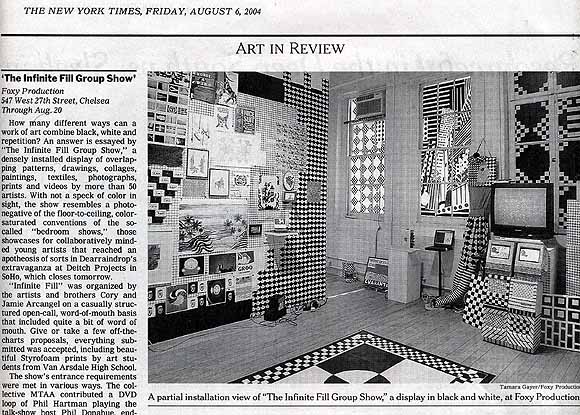
Below: Zoms Zoms at Boogaloo bar in S. Willliamsburg, August 5, 2004. High-energy hardcore synthpop trio from Austin, with a heavy art/noise component. Surprisingly rocking. Songs are short and got the crowd going: I imagined an A&R guy hanging around, thinking, "Great, great, how can we ruin this?"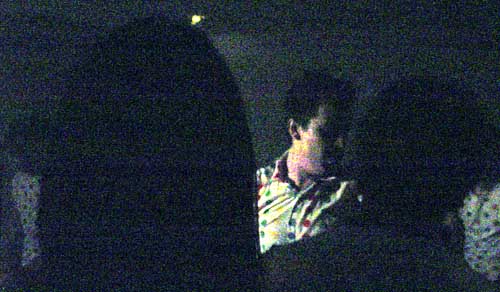 Although the band expressed concern that the sound mix submerged the singer in these "vocally driven" songs, I liked the prominence given the guitar, which I noticed less on the recorded songs I've heard: an orgiastic, Beefheart-Henry Kaiser jangle balancing out the fast metronomic beats and synth woops. The band has .mp3s on websites here (myspace.com) and here (main site). "Static" and "TV" are recommended. |
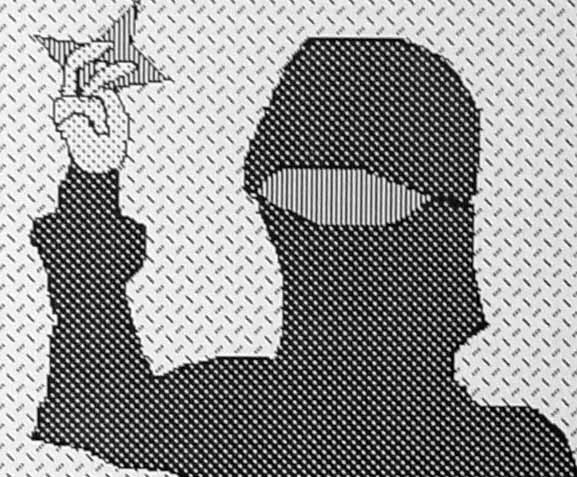
More work from the "Infinite Fill Show." Above: Kevin McGarry, NIN.gif (detail). In the lower part of this image, not shown here, the ninja is carrying a scythe like the Grim Reaper--is this some game character I don't know about?
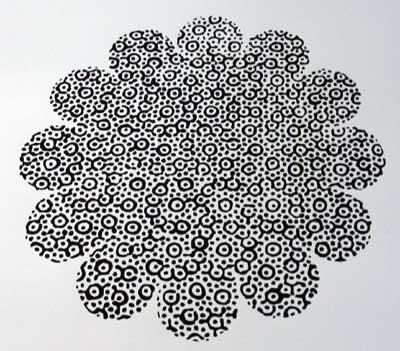
Louisa Minkin, Blindspot (detail of watercolor).
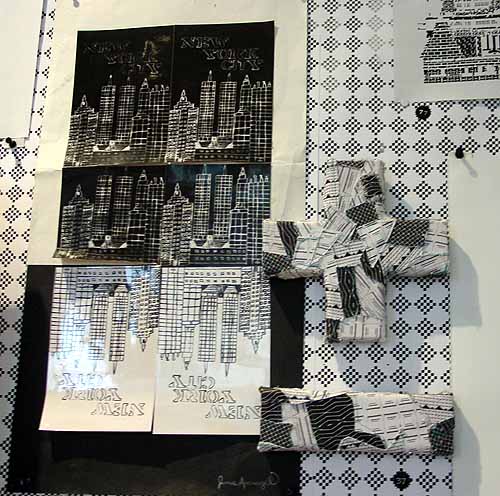
Jamie Arcangel did the New York City collage (in high school) and LoVid the patchwork plus and minus.
I just posted the comment below on the Agonist comment board, in response to editor Sean-Paul Kelley's report on a recent Fahrenheit 9/11 panel in San Antonio. "Where Moore went overboard is to suggest that Bush's family's financial ties to the Saudis were in any way a factor in the President's decision to go to war in Iraq," Kelley quotes Jan Jarboe-Russell, who he describes as "thoughtful and even-handed" and "known for her progressive stance on issues," despite the fact that "neither the [San Antonio Express-News] nor Texas Monthly, two publications she writes for, are beacons of the Left."
My comment:
I wasn't left with the impression that was what Moore was saying; maybe he did and I just discounted it, unlike the "liberal" who is making such a big deal of it. The "Saudi connection" part of the film gives a quite plausible reason why the Bushies were asleep at the switch on 9/11 and then sought to cover it up afterward. The Iraq part of the film mentions the standard reasons for the invasion--WMDs, "terrorist" activity, oil. I think it takes work to conflate the two parts of the film into "the Saudis wanted us to invade Iraq." The closest line I could find in the transcript is "I wonder if Mr. Bush told Prince Bandar not to worry because he already had a plan in motion"--which suggests Bush had a way of diverting attention from the Saudi connection and meeting some other Administration goals, not that Prince Bandar was a "factor" in the decision. Why do so-called liberals work so hard to undermine this movie?
Retired Pentagon analyst Karen Kwiatkowski on the 9/11 Commission whitewash, I mean report:
I naïvely expected more constructive and useful information in the report. A detailed discussion of FBI whistleblower Coleen Rowley and how her observations and actions led to change would be nice. She merited a brief mention in footnote 94. That is all.
I expected to hear how WTC 7 collapsed. The leaseholder of the building told the media it was "pulled." I expected to see more discussion of the mechanics of that presumably unplanned demolition in the evening of 9-11 as well as the collapse of the both 110-story towers, both impacted differently, both falling almost identically. Do we have an engineering design flaw no one knew about? It didn’t come up in the report.
The Commission concluded that the FAA was not really capable of giving the military what it needed to know. Things have certainly gone downhill since 1999, when [golfer] Payne Stewart’s twin engine Learjet quietly drifted off its flight plan, and was escorted by military jets from Eglin AFB and Tyndall AFB in Florida, ANG out of Tulsa, and out of Fargo, for several hours across several states before it ran out of gas and crashed in South Dakota. The difference was that Stewart was just a guy in a single private plane off course with no explanation, while on 9-11, it was one, no two, wait – three, I mean four jumbo passenger jets. Unlike Stewart’s plane which simply left its flight plan and was unresponsive, the FAA actually had hijack warning on AA 11 at 8:19 a.m., UA 175 at 8:52 a.m. After two hijack warnings, AA 77 made an unauthorized turn at 8:54 a.m. The Herndon Control Center knew UA 93 was hijacked at 9:34 a.m.
The commission reports the first fighter jets from Otis ANG Base were scrambled for AA 11 thirty-four minutes after the first hijack alert and again, from Langley AFB, a half hour or so later. At 10:38, fighter jets from Andrews AFB were airborne. None had a visual on any of the four planes plane until it was too late. In 1999, more military jets were on the job watching a lone Learjet over the Midwest than in the 2001 response to multiple hijacks on the densely populated East Coast. Rumsfeld and Wolfowitz should have both been fired at the time, saving us the trouble and expense of criminal trials for their roles in fomenting the unjustified and gratuitous Iraq war.
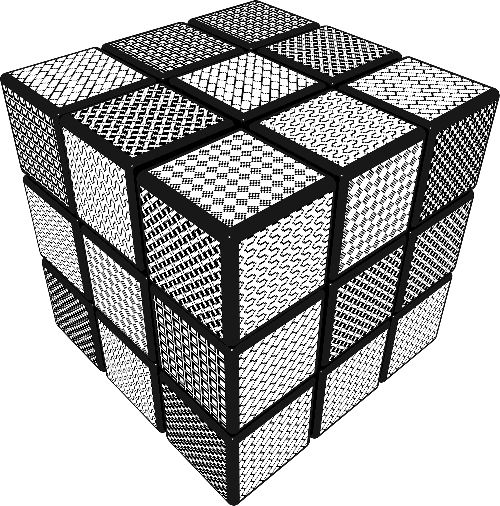
Jim Hamlyn, original .GIF, printed out for the "Infinite Fill Show." This image has been resized, the full image is here.
More about the show: Walter Robinson mistakenly describes the content in his Weekend Update column as "psychedelia and goth." Maybe he pasted in a paragraph from an old Whitney Biennial 2004 review by mistake? You have to stretch to find anything goth in the show, and psychedelia kind of implies color to most people these days, doesn't it? The keywords here are "Op Art" and "geek." Also, it's hard for me to imagine the phrase "eternal youth culture" coming out of the Foxy Production gallerists' mouth: who talks about shows that way? Besides, it's redundant, as I've argued on this page repeatedly: all of American culture is "eternal youth culture."
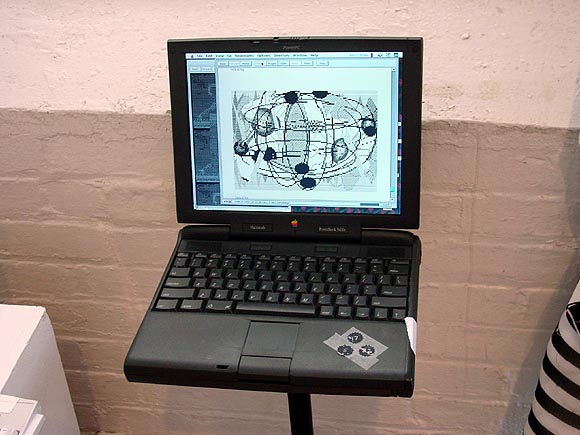
"Infinite Fill Show" installation view of collaboration: jimpunk (www.jimpunk.com) vs. tom moody, 2004, running on Netscape (slower than here, but it's fine that way, too). The gallery listed my and jimpunk's animated .GIFs as "URLs, not for sale" because I was too big a dork to burn them on a CD and demand several hundred thousand bucks for them. The small circles taped on the powerbook are checklist numbers.
Looks like there's going to be some national press for the show; I plan to keep posting about it, with more pictures coming, etc. This will be diary-style reportage, not criticism per se, since I'm obviously not detached.
